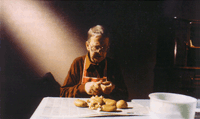Composed as a fiction film based on Buyens’s autobiographical novel, re-enacted with the intimacy of a documentary, but framed from the observational distance of an essay, Frans Buyens and Lydia Chagoll’s Less Dead Than the Others resists facile categorization – alternating between poignant crystallization of living memory in the aftermath of his younger brother’s accidental death and his parents’ struggle with terminal illness, and an impassioned polemic on a person’s right to die with dignity. This idea of inhabited contradiction is established in the opening sequence, crosscutting between the somber procession of mourners lined up for a casket viewing (presumably, of Buyens’s mother) and the animated, candid shots of his mother (Dora van der Groen) pulling together an important occasion outfit from her wardrobe (which she is shown wearing later in the film while packing for her hospital admission) and performing calisthenics in the kitchen. In hindsight, the juxtaposition of these contradictory images – life and death, stasis and activity, reality and dramatization – reflects his mother and father Jozef’s (Senne Rouffaer) daily routine following the death of his brother, Armand (Koen De Bouw) from severe burns, having worn a gorilla suit for a costume ball that was accidentally set on fire by a pair of half-drunken revelers throwing lit matches at a crowd (and who, rather than help douse the flames, instead went to get a last drink before leaving).
For his parents, Armand’s death also relegates the present to a constantly rewinding past, where the ritual of grief metamorphoses into a mythology of the dead (a sentiment that is also implied in his mother’s observation that Armand, like Jesus, died at the age of 33): re-reading newspaper obituary clippings that described the funeral (which his mother was too inconsolable to attend), revisiting commemorations given in his brother’s honor by friends and colleagues, looking through old photographs of family vacations and happier times, re-evaluating decisions made throughout their lives that aligned to meet his tragic fate. Languishing in a hospital for ten days before dying alone at night – the less familiar, off-shift nurses failing to realize that his repeated calls for “François” were for his brother – the experience would also mark his parents in another way, as they faced their own mortality.
Confined to a hospice after being diagnosed with incurable cancer, his once physically fit father – an avid dancer and tireless labor activist – would endure the emotional roller coaster of several false alarms over his imminent passing, isolated from his family, slowly wasting away, but resigned to a lingering death by an exceptionally strong heart. The specter of Armand’s unanswered calls for his brother also hovers over Jozef’s death, in Buyens’s admission that he ignored his father’s pleas to help him end his life. Alternating between antiseptic images of his ailing father confined to his hospital bed, and color-saturated shots of him dancing and casually dispensing advice from his favorite chair, the stark juxtaposition not only illustrates the disconnection between Jozef’s mind and body towards the end, but also reinforces the image of his coexistence between life and death, both as a grieving parent who never recovered from his son’s death, and as a patient struggling with terminal illness. In contrast, the image of his mother’s subsequent return home after an unproductive extended hospital stay is warm and bathed in light. Reconciled with her fate, the stillness of her death seems paradoxically ecstatic – a peaceful deliverance from a body wracked with constant pain. In a way, by passing unnoticed between life and death, she liberates her son from the guilt of survival that had once consumed them and, in sharing the intimacy of her final moments, enables his own lonely transition to a life without her: “I don’t know when she died. I didn’t see it. I didn’t feel it. I didn’t hear it. Her life passed into mine. She is less dead than the others.”
© Acquarello 2008. All rights reserved.
